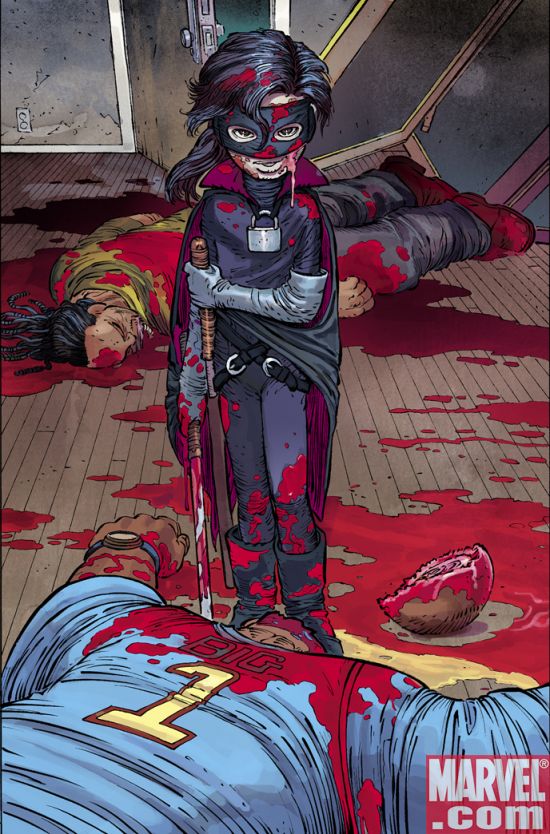
Within the first few pages of Scottish comic writer Mark Millar’s most recent project, “Kick-Ass,” you’ll be laughing. By the end of the first issue, you’ll be wondering why you can’t wait to read another.
“Kick-Ass” challenges the conventions of the superhero comic, mocking and respecting them at the same time. Ordinary high school student Dave Lizewski loves superhero comics, and in the absence of real superheroes, he decides to be the first person to actually become one.
Dave’s first venture into the superhero business isn’t gloriously heroic. It isn’t an amazing victory. In fact, this amateur hero just gets so badly beaten that when he puts the costume on a second time, after months in the hospital and just getting off his crutches, it just seems as if he has a death wish.
So what’s so special about Dave Lizewski, then? Nothing really, except for his determination. When a video of the costumed teenager protecting a man from a beating shows up on YouTube, that determination inspires other normal people without super abilities to don the cape and mask. And Dave’s masked alter-ego finally gets a name: Kick-Ass.
“Kick-Ass” is full of references to other comic heroes such as Batman and Wolverine, and Dave aspires to be like them. Myspace is his version of a Bat-Signal so that he can find jobs and get the media attention he’s starving for.
Millar’s story is witty, hilarious, and a bit twisted. But should we expect any less from the writer that introduced us to the delightfully sickening “Marvel Zombies” series in a story arc of “Ultimate Fantastic Four”?
The characters are unique and pretty fascinating, and on some level, they’re easy to relate to. They’re really just doing what many readers of superhero comics have probably entertained the fantasy of at one time or another.
Dave’s basically a bored kid out there for a thrill that we get vicariously through reading comics. Of course, when you’re a geeky teenage boy pretending to be gay just to get closer to a cute girl, maybe the thrill of real crime-fighting is the only way to hang onto some level of masculinity.
 It’s too bad for Dave that there’s a ten-year-old girl out there that can do the job with more ease than he ever could. Hit Girl steals the panel from the moment she is first shown skewering a bad guy with one of her swords. The pain that this preteen can inflict is frightening, but something about her, even covered in the midst of all the blood and gore, is almost adorable.
It’s too bad for Dave that there’s a ten-year-old girl out there that can do the job with more ease than he ever could. Hit Girl steals the panel from the moment she is first shown skewering a bad guy with one of her swords. The pain that this preteen can inflict is frightening, but something about her, even covered in the midst of all the blood and gore, is almost adorable.
And that crazy Armenian guy who jumps to his death while trying to fly in the first three pages of issue one? The comic book wouldn’t have been the same without him.
John Romita Jr., co-creator of the comic, fleshes everything out gruesomely, with a generous amount of blood and guts splattering across the pages. If you want to see a sword slice through a man’s head, look no further than this series. Readers can enjoy “Kick-Ass” for many of the things that make “Marvel Zombies” such a charmer.
Thanks to Romita, the characters all have their appropriate physical traits and quirks. Dave’s lankiness suits him, and it’s especially noticeable every time he wears his green and yellow spandex costume. Big Daddy is so massive that he looks as if he could break skinny Dave over his knee without flexing a muscle.
“Kick-Ass” isn’t for the squeamish or anyone easily offended by overt violence. And you certainly shouldn’t bother reading it if you’re unwilling to open your mind to see it as more than something silly. It takes a special sense of humor to appreciate something like this. Otherwise, the seemingly absurd violence and bloodshed might obscure that this actually is a commentary of what happens when fantasy and reality collide where they shouldn’t.
While Dave treats everything as somewhat of a game (he’s usually more concerned with logos, superhero team-ups, and getting the credit for his often sub-par good deed than with actually making a difference), there is some seriousness to the series. Dave’s father is seriously in debt, thanks to the first hospital visit that being a “hero” earned him. Hit Girl and Big Daddy come from a pretty dark background and have a mean streak when they fight mobsters and drug dealers. And the people that Kick-Ass is interfering with don’t take it lightly.
Real danger exists in this “real world,” and no vigilante is invincible. They don’t even have any special abilities, just normal human ones that they can work to perfect. Apparently the Armenian guy was never told that, and, as funny as his failed flight might be, that’s just another reminder of how dangerous it is to believe you can achieve the stuff of fantasy.
The biggest threat to super-heroism in the comic world is normality, and Millar knows that well. After all, ordinary people scared of masked vigilantes and villains were the sole reason that the controversial Superhero Registration Act was passed in Millar’s “Civil War,” the Marvel crossover event that pitted hero against hero.
The first six issues of “Kick-Ass” embody the normality that threatens super-heroism. With two more issues to come in this story arc, we’re all about to find out whether or not a real hero can exist.






